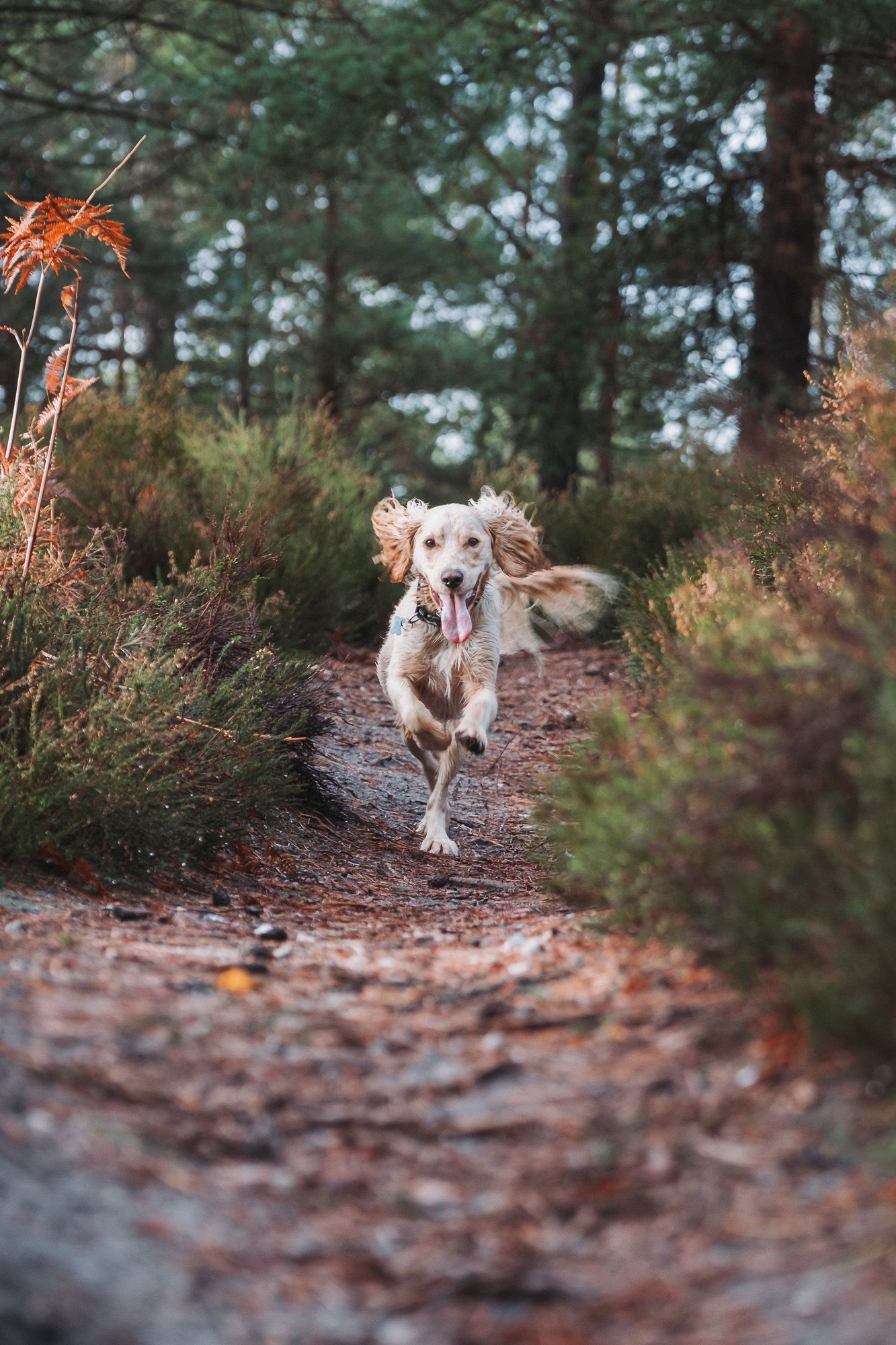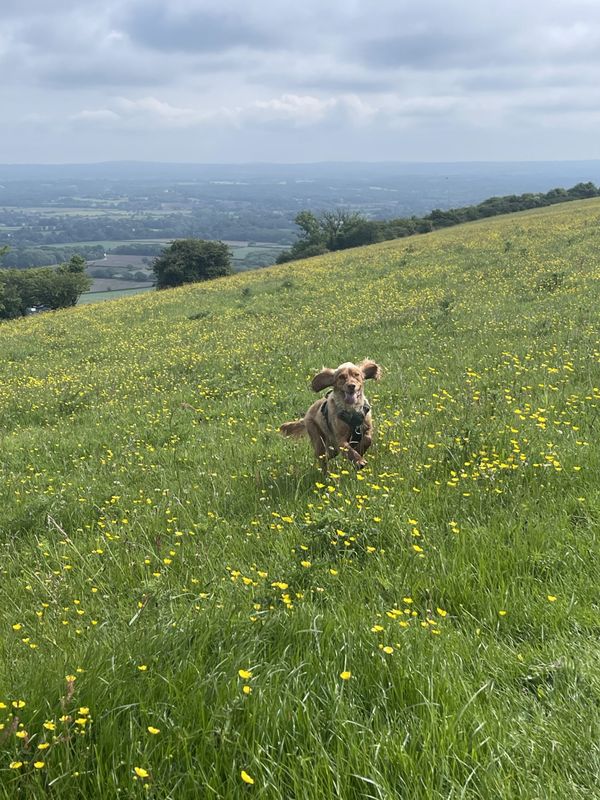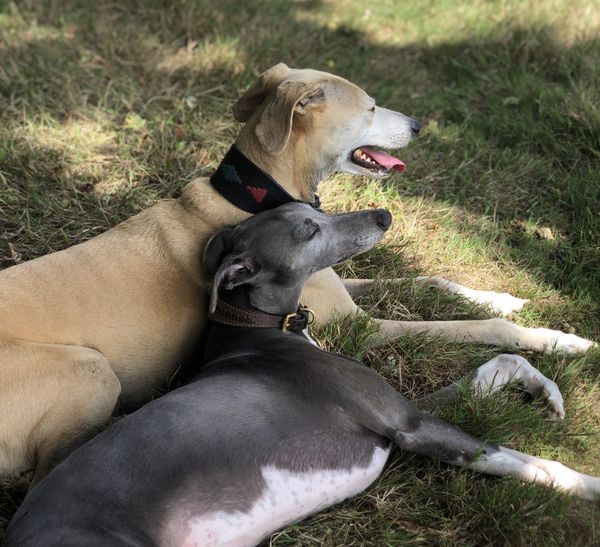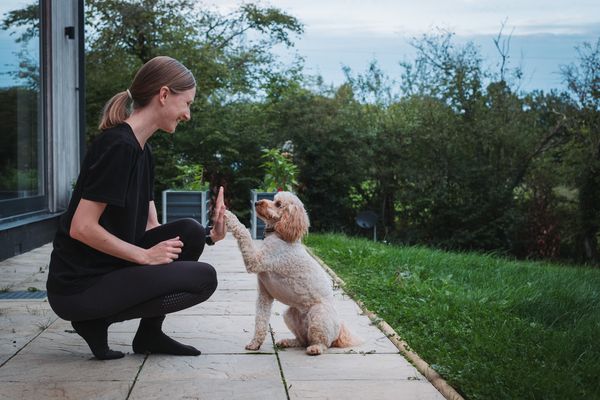We’ve been honing our dog portraiture skills for five years as full time travelling pet sitters. To date, we’ve cared for almost 140 different dogs! From Great Danes to Chihuahuas, we love spending time capturing their personalities and providing their owners with sweet portraits during our stay. The most common questions pet owners ask us when they see the photos are ‘How did you get them to stay still?!’ and ‘How did you get them to listen to you?!’. We consider ourselves a fantastic team in this way, working together to get the pawfect pawtrait (sorry!). Here are our top tips for taking great dog portraits, whether you’re a team like us or by yourself!
Choose your location
The perfect setting for a dog portrait will frame your pooch and contribute to the vibe of the photograph, without stealing focus. Natural or uncomplicated backgrounds work best for this, whether it’s a solid-coloured wall or a hillside with complementary colour tones. The details of your dog’s face will stand out more if you choose a simpler background, especially if your dog has dark coloured fur. In addition to finding a beautiful spot, consider choosing a setting your dog already knows and loves – this will put them at ease and therefore make capturing their portrait that much more straight-forward.
Always think about your lighting too – shooting into the sun might make a great silhouette photo, but for a portrait it’s best to have the sun behind you. Golden hour is a photographer’s ideal time to shoot, when the sun hitting the horizon floods the landscape with an orange glow, casting long shadows and providing gorgeous colours for your shot.
Set up your shot before using commands
While we plan certain shots from time to time, sometimes we just stumble on a great spot for a dog portrait while on our walkies and we have to spend some time figuring out the shot. You might be in a hurry to get your portrait, especially if you’re losing daylight on a walk, but it’s best to set everything up before asking your dog to wait, sit or stand in frame. This ensures you keep their attention from the start of shooting, and your dog won’t get fed up with you asking them to wait over and over again! You can achieve excellent portraits using only your phone, but if you have a camera that requires optimising the settings, or a tripod that takes a few minutes to set up, it’s best to do this before asking your dog to give you their attention. Chris has become adept at speedy tripod set-ups after years of taking dog portraits!
Get your pooch’s attention
We usually find that gasping or saying the classic ‘What’s this?’ is enough to get a dog’s attention for a few seconds, which is usually long enough to snap a couple of portraits of them looking at the camera. If your dog gets wise to this quickly, bringing toys – even ones that don’t make a sound – and dangling them above your lens is another good way to get them to look at you too. (This can have mixed results if they get too over-excited, or if a squeaky toy makes them go crazy!) On quiet walks through woodland or forests, Chris has found that simply clicking the shutter is enough to get a dog’s attention if it’s a peaceful place. Knowing what works best for your dog without getting them too over-excited will mean you have more opportunities to capture your portrait.
Be firm with commands
We always find it easier to take portraits when dogs have been trained to respond to certain commands. As pet sitters, we sometimes find that a dog hasn’t been given much training and our stay with them is too short to make any real progress with teaching commands. Having said that, you’d be surprised at how often we find dogs naturally understand ‘Wait’ combined with a flat palm gesture, or ‘Sit’ combined with closed fingers pointing upwards. Speak clearly so the dogs know what they have to do, and be patient if they get distracted easily! Know when it’s time to move on, but make sure you’re being clear with your commands before you give up on your shot. Giving direction is usually Suze’s job – standing behind Chris while he shoots and firmly giving commands, so Chris can simply concentrate on taking the portrait!
Pay your model
What’s the love language of dogs? Treats! When dogs are responding to us and posing so well for photos, it’s important that we reward our four-legged friends with their favourite treat. We always take our treat pouch from Dicky Bag with us for this reason! If your dog isn’t food-orientated, their favourite toy or excitable praise and a good pat is a good way to reward them for a job well done. If you consistently reward them for good behaviour after a successful photo session, they’ll remember this positive praise the next time you want to take portraits and the whole process will be smoother every time – win-win! You can also check out our tips for bonding with pets!
Have fun!
Some of our favourite dog portraits from our travels are those that were taken while we ran up and down beaches with puppies, played endless games of fetch in the park, or simply took the time to find a fantastic viewpoint to capture a dog in their element. Make your photoshoot fun for your dog too and they’ll love taking part! Get down on the floor with them, play tug of war, chase them, talk to them and throw toys. If your puppy isn’t good at sitting still, more dynamic shots are a great way to capture their energy and make a portrait more interesting.
A portrait doesn’t just have to mean a dog sitting still and looking at the camera. Sometimes the ‘outtakes’ are better than the shot you had planned in your mind! A speedy Spaniel who loves the outdoors will look great running down a woodland track. An elderly dog who loves to curl up and snooze will look sweet in their favourite chair – especially if you set up a cosy nest of blankets for them to nuzzle in to. The best dog portraits highlight and celebrate their individual personalities, and in a world of overly-curated social media feeds, showing your dog doing what they naturally love to do can be the most beautiful portrait of all. For more information about the camera equipment we use, head to our photography gear page.
If you found this post helpful, please support our blog by donating as little as £1 to our running costs! Thank-you!
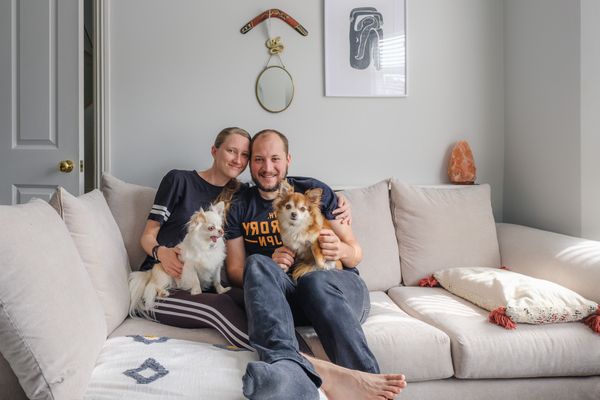
We are Chris+Suze

Thank you for reading!
We hope you’ve enjoyed this post! For more posts about photography, head to our blog or follow us on Instagram and Facebook for photos and videos from our travels! Let us know in the comments if you found these tips helpful, and if you have any pawtrait photography tips of your own!
